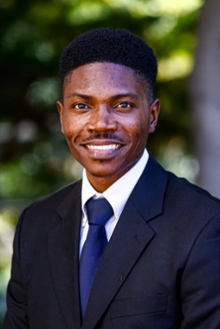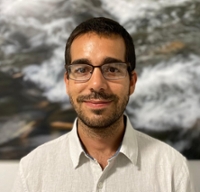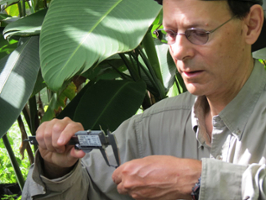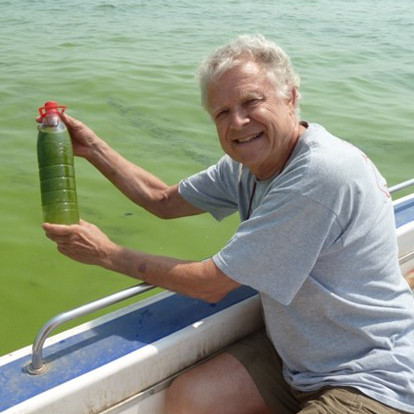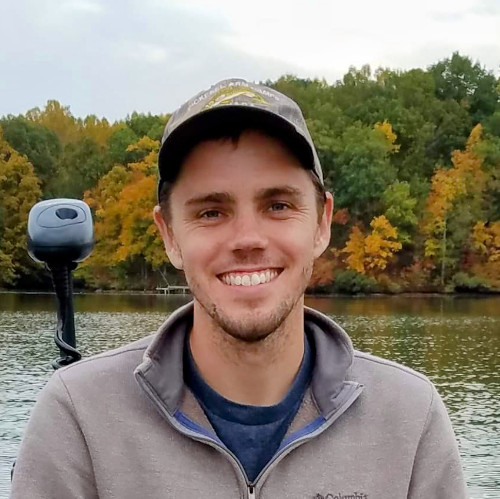Webinars
Hurricane Ecosystem Response Synthesis Network
With each webinar, the HERS team would like to facilitate connection within our Network, progress on upcoming research on the ecology of tropical cyclones, and help share the latest findings in HERS related research.
Please check out our tabs below for our upcoming and past webinars. In addition to hosting invited speakers, we will also use these virtual meetings to help form working groups interested in investigations related to our three research focal themes: (i) interactions among ecosystem pre-storm conditions and storm characteristics on ecosystem responses, (ii) roles of eco-evolutionary history, life history, and biodiversity on ecosystem responses, and (iii) feedbacks among natural and social-economic systems that confer resistance and resilience to tropical cyclones.
Upcoming
|
|
|
|
Past
November 11, 2022: Dr. Rushaine Goulbourne "The Labor Market Impact of Hurricanes, Evidence from Florida Counties
Dr. Rushaine Goulbourne Environmental Economist Climate Risk Analyst at Freddie Mac Webinar Recording HERE
Abstract: This study investigates the impact of hurricanes on wage and employment growth. I utilize a model of wind intensity to measure the strength of hurricanes within each Florida county. By using a measurement technique that accounts for hurricane intensity variation over time, the results provide evidence that estimates from the previous literature have overstated the true effect. In many respects, the literature supports the notion that hurricanes affect labor markets through labor supply. My results indicate that labor demand also plays a role in post disaster labor market outcomes. As a novel contribution to the literature, I test this result using propensity score matching while accounting for the probability of hurricane exposure in each county. My results suggest that hurricanes depress not only employment growth but wage growth as well. Short Bio: Rushaine Goulbourne is a graduate of the University of Alabama (Tuscaloosa) where he received his PhD in Economics. His areas of research include Environmental Economics (focus on natural disasters), Urban Economics, and Regional Economics. Upon receiving his PhD, Rushaine did postdoctoral studies at the Brookings Institution where he worked on Climate risk and housing issues. He now works at Freddie Mac as a Climate Risk analyst where he continues to work on housing and the impact of natural disasters. In his spare time he enjoys photography, singing and exploring the outdoors. |
October 20th, 2022: Dr. Lori Peek 'The Power of Convergence: Interdisciplinary Extreme Events Research and Reconnaissance'
Dr. Lori Peek
Webinar Recording Available Here Abstract: Disaster researchers have long made the case that it is important to arrive at the scene of disasters as quickly as possible to collect perishable data and to ensure its validity. This commitment to experience-near research has existed since the field’s inception. Indeed, generations of researchers have been trained by engaging in post-disaster reconnaissance or quick response research or rapid research which has led to fundamental advances in the social and physical sciences and engineering that now inform emergency management practices and modern building codes and standards. In hurricanes and other large-scale disasters, however, this research activity has been called into question because of challenges associated with: (a) the lack of coordination among large numbers of engineers, physical scientists, and social scientists; (b) a groundswell of researchers with limited knowledge of the affected areas and a lack of time to conduct proper literature reviews or become culturally competent; and (c) the potential to overwhelm affected people, local researchers, and public officials. These concerns are legitimate and should be taken seriously. At the same time, the need to learn from hurricanes and other weather-related disasters is more pressing than ever as larger numbers of people—and especially those living at the margins of society—are affected by extreme events. This presentation will take the position that when research teams broaden their research framework to also center considerations of research ethics and social justice, post-disaster reconnaissance can be ethically informed, scientifically rigorous, and carefully coordinated. This requires a rethinking of some of our traditional approaches to fieldwork, however, which is part of the mission of the National Science Foundation-supported CONVERGE facility. CONVERGE, which was established in 2018 as the first social science-led component of the NSF-funded Natural Hazards Engineering Research Infrastructure (NHERI) for the U.S., is concerned with advancing convergence research for the hazards and disaster field while training and mentoring a diverse next generation of researchers. It brings together large networks of researchers from geotechnical engineering, the social sciences, structural engineering, nearshore science, operations and systems engineering, environmental engineering, public health, and interdisciplinary science and engineering. This presentation will introduce a framework for doing convergence research, share resources to promote interdisciplinary data collection and data publication, and describe the ongoing activities of CONVERGE. Short Bio: Dr. Lori Peek is director of the Natural Hazards Center and professor in the Department of Sociology at the University of Colorado Boulder. She is principal investigator of the National Science Foundation-funded NHERI CONVERGE initiative and the Social Science Extreme Events Research (SSEER) network. She wrote the award-winning book Behind the Backlash: Muslim Americans after 9/11, co-edited Displaced: Life in the Katrina Diaspora and the Handbook of Environmental Sociology, and co-authored Children of Katrina and The Continuing Storm: Learning from Katrina. Peek helped develop FEMA P-1000, Safer, Stronger, Smarter: A Guide to Improving School Natural Hazard Safety. In 2021, she was nominated by President Joseph Biden and approved by the U.S. Senate to serve on the Board of Directors of the National Institute of Building Sciences. More information including access to recent publications is available at: https://hazards.colorado.edu/biography/lori-peek. |
May 10, 2022: Soil biogeochemical response to hurricanes and drought in a wet tropical forest in Puerto Rico
Dr. Omar Gutierrez del Arroyo
|
April 19, 2022: The resilience of subtropical mangrove ecosystem services following a series of distubance events
Dr. Anna R Armitage
|
March 2022: Effect of hurricane Maria on pollination and natural selection in a specialized hummingbird-plant pollination system in the Eastern Caribbean
Dr. Ethan J. Temeles Department of Biology, Amherst College
|
February 2022: Effects of a major hurricane on a guild of esturarine predators
Dr. Bradley A. Strickland
|
January 2022: The engineering performance of mangrove ecosystems to mitigate the effects of hurricanes on our built environment
Dr. Tori Tomiczek
Rising seas, tropical cyclones, and tsunamis threaten increasingly populated coastal areas, leaving coastal communities searching for sustainable, resilient adaptation solutions to mitigate the impacts of chronic and acute coastal flood hazards. While various hazard mitigation alternatives spanning the green-gray engineering spectrum have been considered, an emerging body of literature has identified natural and nature-based features (NNBF) as effective in attenuating waves and water levels over land and providing co-benefits including carbon storage, habitat, and recreation. However, uncertainty about the engineering performance of these systems limits their widespread application in coastal planning and design. This work investigates parcel-scale effects of the Rhizophora mangle subject to waves. Post-storm damage observations after Hurricane Irma in the Florida Keys identified that near-coast residential structures shielded by mangroves of 10-50 m cross-shore width consistently experienced less damage than neighboring structures with other shoreline archetypes. Based on these observations, a prototype-scale physical model of the Rhizophora trunk-prop root system was created to measure mangrove effects on hydrodynamic transformation and wave load reduction on sheltered inland structures. A method for quantifying the projected area of a mangrove forest for predicting wave attenuation was also developed. Results indicate that Rhizophora forests of moderate cross shore width have a measurable effect on wave attenuation, with wave height decay dependent on water depth and forest density. However, a balance between the desired engineering performance, ecological requirements, and social considerations are required to successfully implement these natural systems to mitigate coastal flood hazards. Ongoing work through NSF will investigate the reliability of these systems by synthesizing field and laboratory experiments and working with experts from academia, industry, and government to inform experimental design and dissemination. |
December 2021: The “new normal” high rainfall tropical cyclones: Linkage to harmful cyanobacterial bloom expansion into estuarine and coastal waters
Global warming is generating more intense, elevated rainfall from tropical and extra-tropical storms, which have led to record flooding along the storm tracks, extending from the coast to inland watersheds. In addition to delivering elevated nutrient (N and P) and other contaminant loads to receiving riverine, estuarine, and coastal waters, floodwater also tend to reduce salinity in these waters. The combined effect of elevated nutrient loads and “freshening” of downstream waters is promoting eutrophication (“new production” from a carbon perspective) and expanding the window of opportunity for harmful cyanobacterial blooms, or CyanoHABs, to proliferate. Elevated stormwater runoff events followed by periods of protracted droughts are the perfect “storm scenario” for downstream proliferation of CyanoHABs, which will benefit from elevated nutrient supplies, depressed salinity levels and increases in water residence times. This, combined with warming is a potent combination of changing environmental conditions favoring expansion of CyanoHABs along the entire freshwater to marine continuum. Examples of this scenario are now evident in numerous estuarine and coastal ecosystems, including the Mississippi-Atchafalaya drainage into the northern Gulf of Mexico, Florida’s coastal lagoons and estuaries draining Lake Okeechobee, the Albemarle-Pamlico estuarine complex in North Carolina, the San Francisco Bay Delta, as well as the Yangtze River Delta in China. This scenario presents multiple CyanoHAB mitigation challenges, in that both watershed nutrient loading will need to be reduced to new threshold levels and water retention strategies need to be optimized to retain and process nutrients in the watershed upstream from CyanoHAB sensitive receiving waters. |
November 2021: Quantifying disturbance and recovery in estuaries: tropical cyclones and high frequency measures of oxygen and salinity
Tropical cyclones are important drivers of disturbance in estuaries. Several mechanisms can lead to storm impacts and estuaries are dynamic and diverse systems, making identifying disturbance and recovery difficult and often limiting studies to one or a few sites or tropical cyclones. We applied a new method for detecting disturbance and recovery to long-term and high-frequency measurements of salinity and dissolved oxygen from NOAA’s National Estuarine Research Reserve System, analyzing the impacts of 59 tropical cyclones at 19 estuaries across the eastern United States. We were able quantify disturbance occurrence, timing, recovery time, and severity and ask what storm and location properties are associated with changes in these disturbance characteristics. Salinity disturbances generally started earlier than dissolved oxygen disturbances and lasted longer. Most recoveries occurred within days, though some disturbances lasted weeks or months. Recovery time was positively correlated with disturbance severity for both variables. Both storm (especially precipitation) and location properties were related to disturbance characteristics. Our findings demonstrate the power of high-frequency, long-term, and cross-system data, when combined with appropriate statistical methods, to provide insights that improve understanding and potentially management of estuarine resilience to disturbances. |
October 2021: Coastal habitat and community responses to tropical cyclones in a temperate, sub-tropical estuary
Dr. Yin San Stacy Zhang Major storms can alter coastal ecosystem structure and functioning in a multitude of direct and indirect ways including habitat destruction, stormwater-related water-quality degradation, and mortality of marine organisms, among others. From 2010-2020, multiple hurricanes of varying intensities impacted the southern Outer Banks of North Carolina. Using a combination of monthly trawls and contemporaneous seagrass and oyster reef surveys, we examined habitat continuity and changes in seagrass-associated fish communities to evaluate whether these disturbances changed the nursery role of shallow-water biogenic habitats. Our analysis revealed that fish catch may be depressed for roughly two weeks after storm passage but over longer time frames, appeared largely similar to corresponding no-storm years. The overall resilience exhibited by fishes was likely underpinned by the relative stability of the seagrass habitat itself, which appeared principally undamaged by storms. However, storm intensity plays a large role in overall storm effect, as the greatest magnitude cyclone in our observation period, Hurricane Florence, not only damaged oyster reefs that had previously been unaffected by earlier cyclones but also caused the greatest decline in fish catches. These findings suggest that fish communities and coastal habitats may be insensitive to mild tropical cyclones, but a pressing question appears to be whether they will remain resilient to storm impacts if the frequency and intensity of these disturbances increase as one syndrome of global climate change. |

